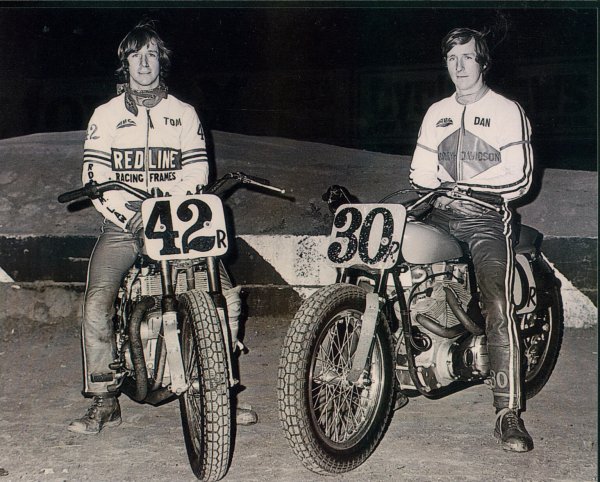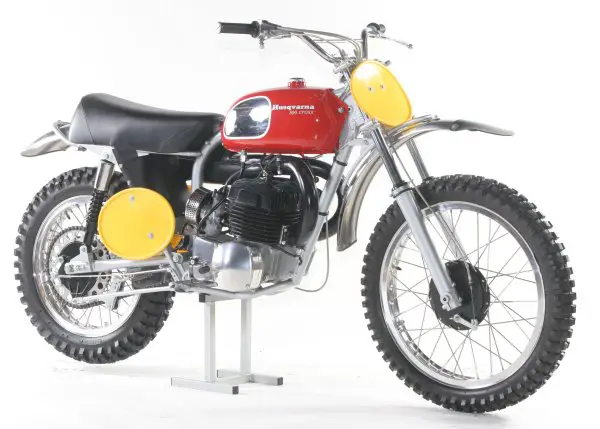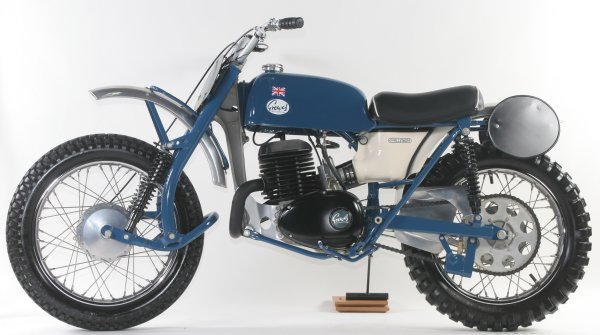THE MXA INTERVIEW: Tom White – The Ultimate Enthusiast
Racer, businessman, curator, and philanthropist, Tom White continues to move the sport forward.
By: Zap

MXA: When did you start riding/racing motorcycles?
Tom: As soon as my brother Dan was old enough for a drivers permit he purchased his first motorcycle, a 1965 Yamaha 80.ÿMy surfer friends and I had a lot of fun picking on him, accusing him of becoming a rebel and a future Hells Angel.ÿRight about the same time, a friend let me take a ride around the block on his Honda 50?well, almost around the block as I couldn’t figure out how to slow the thing down for a corner and crashed into a parked Cadillac.ÿAfter paying $65.00 in damage later, my parents decided that I didn’t have the necessary coordination to ride a motorcycle..ÿ
In my senior year of high school I was gainfully employed as a bus boy at a restaurant and I purchased my first motorcycle, a ’67 Yamaha 100cc Trailmaster.ÿWe had a big dirt pit near our house in
ÿ

Tom: Though racing is a lot more lucrative these days, the fact remains that only a few riders make enough money to support a proper race program.ÿI worked at Orange County Cycle, the number one motocross dealership on the West Coast and Dan worked for the
In 1975, I decided to start my own business.ÿThe name was Tom White Cycle Specialties and I had hoped to sell the products that I had designed at OCC and still continue racing.ÿ That hope was dashed just after I signed the lease for the building when I hit a guy head on at
ÿ
White Brothers, what a ride over the next 25 years that featured the happiest and saddest parts of my life. The happy stuff was being involved with riders like Bob Hannah, Marty Moates, Brad Lackey, Scott Parker, Chris Carr, and Scott Russell. I enjoyed working with some really great employees, customers, and vendors in an industry that you are passionate about. Possibly the best part to this date, is having access and friendships with many of my hero’s.ÿThe sad stuff was having very little time for your family, my son’s tragic accident, my brother’s leaving the company, and losing touch with so many people that helped grow White Brothers.
ÿ
MXA: So when did things really change for you and the company?
Tom: They say timing is everything in life and in January of 2000 I was approached by a representative of a
ÿ
MXA: Is it true that White Bros.’ first real foray into motocross racing was with Marty Moates at the USGP inÿ
Tom: One of the very first products that White Brothers marketed was a long travel kit for the earliest (1975) Yamaha monoshocks. We soon became recognized as the experts for improving the performance of this new and unique design. By 1979, Laurens Offner had put together a privateer race team under the name LOP which stood for Laurens Offner products. He approached Dan and I about doing the rear suspension for the YZ Yamahas to compliment the Simons Forks that he used on the front end. We had a very talented suspension mechanic at the time named Bill Rychlik who worked with the team riders to improve the suspension.ÿ LOP’s top rider was Marty Moates. With Marty as the test rider, Bill and my brother Dan tried extensive modifications to the stock shock to try and make the production equipment as good as we could make it. The shock was extended to offer travel well over twelve inches, a huge remote reservoir was added to minimize fade as the shock heated up, valving was completely redesigned, and we added an additional spring to improve suspension over smaller choppy bumps on the track.
ÿ
We all know the story of how, on that June day in 1980, Marty shocked the factory establishment by winning the United States Grand Prix at
 ÿ
ÿ
MXA: What’s the story about you building a Supermoto bike for World 500cc Champion Brad Lackey!
Tom: When Gavin Trippe started the made for TV Superbikers event with the goal of determining who the fastest rider was; a motocrosser, roadracer, or dirt tracker, the factories built special bikes for many of the top riders. Yet some of the top riders like Lackey didn’t get any support from the teams. Possibly cost issues or because Brad had just won the World Championship his way ? using his own sponsors and making major changes to the factory bike like using the Simons forks instead of the factory forks, Suzuki here in
ÿ
I wish I could tell you that we won, but in fact Brad wasn’t that competitive on our bike.ÿ At 465cc, the Suzuki was smaller that all of the other bikes, and I don’t think Brad ever felt that comfortable on the pavement. Never the less, we were proud to have had the opportunity to build the bike for the World Champion and ended up building machines specifically for this event for Steve Ecklund, Warren Reid, and Speedway World Champion Peter Collins before the event went away in the mid 1980’s.
ÿ
MXA: Which segment ? MX, ATV, Harley, Watercraft, Mountain Bike, or Street was most successful for WB?
Tom: At the time of the sale of my company to MAG, we printed five different catalogs for the different markets with a total page count of over 1300 pages. The off-road and ATV catalog at over 750 pages was our biggest and because we lumped our motocross, off-road, and ATV sales together that was our most successful market.ÿ But far and away the most profitable was the Harley market. As suspension specialist’s we had developed a strong following for our suspension lowering kits and we had a excellent sales for our Porker Pipes (large 2 ¬” straight pipes) and our E ? Series pipe that utilized tuned discs for max performance. I guess I liked the Harley market because we approached that business with some fresh ideas, really enjoyed the people, and even had the Harley factory race team running our suspension. I don’t think anyone ever thought that a couple of dirt bikes guys could be successful in the market which made it even more fun!
ÿ
Tom: White Brothers was the first company to be purchased by the venture capital firm that would later include eight companies and as a group would be called Motorsport Aftermarket Group. At the time of the acquisition, we had 165 employees, a warehouse in
Initially, after the acquisition we automated the warehouse and ramped up this business model that focused on manufacturing and distribution. It is my belief that as the Motorsport Aftermarket Group grew with manufacturing segment champions like Vance and Hines, Performance Machine, and Renthal, that White Brothers as a distributor who competed against the big distributors, was detrimental to the group. The decision was made for White Brothers to focus on manufacturing and proprietary products. Unfortunately, this would prove to be a very tough road to be successful and profitable at.ÿI feel bad that so many good people lost their jobs and that the acquisition wasn’t successful for MAG. The most recent announcement that WB has been acquired by Vance and Hines should be a good thing.ÿI’m quite confident that by combining the best WB people like Tom Morgan and Alan Olson with the Vance and Hines design and engineering people, that Vance and Hines will become a key player in the off-road and motocross markets.

Tom: During the White Brothers years I started collecting early motocross bikes, first was a Greeves that I planned to restore with the help of my young son Brad. Though I had never raced Greeves I just loved the look ? so agricultural! We did manage to get it apart, but we soon realized it was more fun to ride them than work on them, so a friend – Denny Berg completed the restoration.ÿ Soon, a Triumph Metisse and a Wheelsmith Maico, restored by Vintage Iron was added to the collection.ÿ By the early 90’s I had somewhat of a focus for the collections.ÿ The focus was bikes that were important in the early years of American motocross.
MXA: You also played a big role in promoting the sports history with the Vet World Championships.
Tom: By 1997, the White Brothers World Veteran MX Championships (founded in 1985) had grown to be a huge event and I decided to honor a person each year that we (Bud Feldkamp ? Glen Helen track owner and I) felt had made the largest contribution to American motocross.ÿThe first year we honored Roger DeCoster, a huge contributor to the growth in
Wham, it hit me! We need to find Edison Dye and bring him out to our event to receive the Lifetime Achievement Award. With so little time before the event, I called both Roger DeCoster and Malcolm Smith. Their response to honoring

Malcolm Smith and Edison Dye
The event was a huge success! We brought
ÿ
MXA: What is your position with the AMA?
Tom: In late 2006, museum Board of Director and Chairman of the Motorcycle Hall of Fame committee Don Rosene contacted me about the possibility of joining the Board of Directors of the AMA’s Motorcycle Hall of Fame Museum.ÿI had met Don in 2001 when I attended the Hall of Fame Induction Ceremony in
I was honored that he would ask me to be involved with the museum that honors the motorcycles and the people that ride them.ÿ Looking back, Don’s description of what my duties would be might have been a little misleading.ÿ He said, “All you have to do is attend three meetings a year, one in Daytona during Bike Week, one during Vintage Days at the museum, and a meeting the weekend of the Hall of Fame Inductions.”ÿ Wow, no problem I thought, I’d be attending those events anyway.ÿ
ÿ
In reality, I was taking on a lot bigger job. My first project was to curate a display that opened up in the museum’s Hall of Legends in July of ’07 simply called “Malcolm!”ÿ I had no idea what a curator did,ÿ just thought I would drive out to my friend Malcolm Smith’s store, pick up some motorcycles and memorabilia, and interview him. I would find out that there is a lot more to it than that!ÿ Malcolm and I would end up going on treasure hunts that had me crawling through his home’s attic, digging into containers in an orchard, and searching through his warehouse’s to find the motorcycles and the memorabilia that would help tell his story in an exhibit. It was amazing to me and telling about Malcolm, these treasures didn’t seem that important to him! I ended up spending several hundred hours on the exhibit. Now that the exhibit is finished, I’m very proud of the way “Malcolm!” turned out and I have even more respect for Malcolm Smith. Besides being a great rider and ambassador for the sport, Malcolm and his family are wonderful people that have really given back.
ÿ

MXA: What is your favorite bike of all time?
Tom: It probably doesn’t surprise you that the 1968 Yamaha 250cc DT1 is my all-time favorite bike.ÿThe DT1 wasn’t a great street bike, nor was it a great dirt bike or race bike, but it was way ahead of anything else as a true dual-sport bike. At the same time as the introduction, Yamaha also sold the GYT kit that gave the bike competitive power for scrambles and/or motocross.ÿ The DT1 would ultimately evolve into the 1974 YZ250A, which at the time, was arguably the best motocross bike available. I still remember how it felt riding that bike down
?the bike got lots of looks!
MXA: How many bikes do you have in your collection?
Tom: Heck, I wasn’t even sure until I went and counted them! The count even surprised me!ÿ I have 118 collector bikes, 3 street bikes, 1 trials bike, and 1 current motocross bike (’08 YZ450F). I have a total of 45 different brands of motorcycles. In case anybody cares, Husqvarna’s total 17 and Yamaha’s come in second at 14.ÿ Please don’t tell my wife, she thinks I’m still under 100!

MXA: Which bike is the rarest or most valuable?
Tom: The only bike in my collection that actually wasn’t a production bike is my ’69 Husqvarna 500cc Twin Cylinder Baja Invader. Edison Dye requested this bike, the third and last prototype built by the factory, so that Gunnar Nilsson and J. N. Roberts could race it in the Baja 1000. Though they won the race, the 500cc twin never went into production as it was deemed too powerful and expensive for motocross. This is the only one left in the world. I estimate the value in the six figures.
MXA: What is it about the old bikes that you admire so much?

MXA: Tom, we’ve asked other enthusiasts this question and it always seems to be a hard one to answer – what is it about motorcycles and/or the sport of motorcycling that inspires us so much?
Tom: Wow, tough question!ÿ I’m just going to address motocross machines and the men and woman that race them. Where most stick and ball sports are about the team, motocross is an individual sport. When you watch automobile racing, you see the speed of the car, but you can’t see what the driver is physically doing to make him faster than the other drivers. That’s not the case at all with motocross! It’s easy to see the difference in what a rider like Ricky Carmichael is doing on the bike compared to the other riders.ÿUnlike the other extreme sports, the race can go on for 35 plus minutes, and you can see how conditioning plays into the race.

Most of us will never reach the level of today’s professional motocross riders. It doesn’t matter!ÿ When we line up and blast into the first turn elbow to elbow with riders with similar skills, we are experiencing a thrill that very few people can relate too. On the track it doesn’t matter how much money you make or how famous you are. It’s about the rider! Few of us use drugs, act out road rage, or get into fights because we go to therapy every week, motocross is our therapy! If someone asks me why I still race motocross at almost sixty years of age, I tell them that because they asked the question that they probably wouldn’t understand the answer. I’m sure most of you know what I mean! Oh, and motorcycle people are the nicest people on the planet!
ÿ

ÿ




Comments are closed.